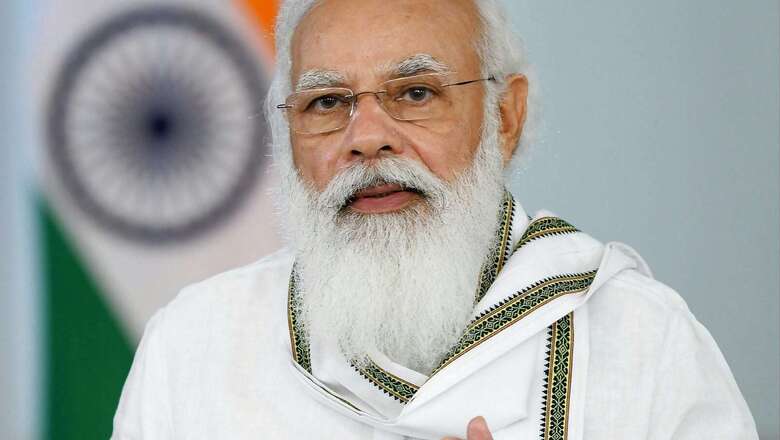
views
The question of where are the Big Bang reforms under the Modi government had long ceased to be asked after a series of reforms such as the three farm bills, the labour reforms, Insolvency and Bankruptcy Code and the banking reforms. But now that the holy grail of Big Bang reforms – sale of Air India – is also done, one presumes that the economic commentary by the self-appointed experts would at least now become more substantive rather than the shallow, rhetorical, “where are the reforms”?
In the post-1991 world, there has been this rather mistaken analysis of classifying everything done in 1991 as the first-generation reforms and then waiting endlessly for the so-called second-generation reforms to kick in. Every time a government moved in on a series of reforms two things would happen – one set of commentators would gushingly rush in describing those reforms as beginning of the second-generation reforms, while an equally long list of commentators would come advising on why these were not reforms but some big bang was needed without ever telling what actually was that big bang (except of course that Air India be sold). Both of these analyses missed the evolution of Indian economic policy-making in the past three decades, were completely out of tune with reality and such commentary was produced primarily for and consumed by a few dozen or so experts.
The reality is, India has witnessed three generation of reforms since 1991 and we are currently in the fourth generation of reforms.
The 1991 period was of course the first generation of reforms. Under Narasimha Rao, the first-generation reforms can be termed as industrial policy reforms which also dealt with export licensing and import norms. It was done under duress, without the conviction of either the policy makers or the political class of that time. That India benefited from the policy is no brainer since what the Industrial Policy of 1991 did was change course from the disastrous path adopted for 40 years before it and the mere course correction was enough to bring immense fruits. But it was India’s misfortune that despite the course correction bearing fruits, neither the ruling party at that that time – the Congress– nor the finance minister in 1991 who later became the Prime Minister, really internalised the need for reforms. The moment the crisis abated, the reforms stopped, and when Dr. Manmohan Singh came back as the PM for a full decade he ran a government that did its best to reverse those gains.
The second generation of reforms, which can be classified as the connectivity reforms, were undertaken under the Vajpayee government between 1999 and 2004. The New Telecom Policy of 1999 fundamentally transformed India in ways which had no previous parallel. To cite one example, the national tele-density stood at below 5% in 1998 and rural tele-density at less than 1%. In just about 15 years, the nation had seen a phenomenal surge. In January 2013, the figures stood at 73.97% and 40%. (Latest data is 90% national and 60% rural). Road construction – National Highways and Rural Roads – was the other pillar of the connectivity reforms that transformed India.
The period between 2004 and 2014 was a missed opportunity for a multiplicity of reasons but most importantly because the man at the helm was never a reformist by conviction and the force of circumstance of 1991, once no longer operating, allowed him an easy retreat into the old settled world of socialist utopia.
Which brings us to the beginning of Modi era in 2014. Many commentators were eagerly waiting for what they thought would be the “second generation reforms”, for the commentariat never really came around to realising the importance of Vajpayee reforms, shorn as it was of a dramatic 1991 historic budget. If Modi had followed the prescription of the experts at the beginning of his first term itself, it would have been logically the third-generation reforms after 1991 and Vajpayee era.
The list of those eagerly awaiting the so-called second-generation reforms also included many well-wishers of Modi. Enthused by Modi’s dictum of “Government has no business to be in business”, they prepared their own list of such presumed reforms and perhaps even the sequencing. But they were in for a disappointment for they neither understood the real India nor its actual needs nor the sequencing of reforms in a country like ours and nor did they understand the politics of reforms.
The genius of Modi lies in inventing a completely new third generation of reforms where none, not even the queue of celebrity experts, saw a need for it much less recognised the fact that such reforms were even needed. Modi not only was able the visualise the pressing need for these reforms but was also able to masterfully sequence and implement it. Modi’s third generation of reforms can be termed as the Fulfilling of Basic Needs Reforms. Most of the first term of Modi went in getting these reforms in place before he went in for the what we are now witnessing – the Fourth Generation Reforms.
In effect, the much hallowed and so called “second generation reforms” are actually the “fourth generation reforms”, that are being implemented now. In between, Modi put in his own signature in the form of third generation. So, what are these third-generation reforms?
Think of the economic policy making between 2014 and 2019 as a sequence of stunningly well-planned moves on the following fronts: Aspirational class, farmers and women.
Aspirational Class: First, ensuring that every family and then every adult has a bank account through Jan Dhan; then ensuring that government benefits reach in full to all, without leakages through DBT; then ensuring minimum social security for all through Jan Suraksha – life insurance, accidental insurance and pension; then funding the poorest through collateral free Mudra loans for self-sufficiency; in the process raising the standard of living of the aspirational class by empowering the people; then ensuring medical insurance for the whole family through Ayushman Bharat.
Farmers: Neem coated urea and other reforms ended the fertiliser scarcity forever; soil health improvement drives all over the country through Soil Health Cards and lab integration; integrating Mandis into one National e-Market through eNAM; Krishi Sinchai Yojana expanding irrigation multi-fold; access to formal bank credit even for small farmers due to Jan Dhan accounts, thus freeing them from vicious loan cycles; Fasal Bima Yojana covering risk at time of plantation; MSP assured at 1.5 times of cost and thus assured price recovery of produce; PM-KISAN for additional benefit for small farmers.
Women: Securing social future of every girl child through Beti Bachao Beti Padhao programme; raising national awareness through nationwide toilet building campaign; securing financial future of girl child through Sukanya Samriddhi Yojana; smoke-free life for every woman through Ujjwala Yojana; incentivise women to become entrepreneurs through collateral free high value Stand Up India Loans along with Mudra loans; incentivise women in formal workforce through EPFO incentives; maternity leave reforms.
It is not that Modi only did these reforms during his first term. The Goods and Services Tax, the Insolvency and Bankruptcy Code, the Diesel Price Deregulation, to just name a few, were some of the path-breaking major macro reforms that were done in the first term itself.
But here is what the third generation of reforms, pioneered by Modi, have achieved. They have built a constituency of policy reforms among the people on a scale where none existed before. It is this social equity that is on the one hand empowering the government to move full steam on the reforms agenda while on the other hand the reforms are no longer only top down driven but there is now an organic bottom ups demand.
Earlier, policy reforms were considered an esoteric subject best understood by those who had either no skin in the game or even if they were vested in India’s well-being, they really belonged to only the top 2%. Modi, sometimes to the consternation of even his otherwise well-wishers, spent much of his first few years in office touting neem-coated urea or Jan Dhan as the reforms that will change India. And like always, he was proved right.
Jan Dhan is by far the biggest reform in India’s economic history if the metric is the sheer number of people it has empowered. The pandemic and the way India was able to reach its poor in almost zero time with cash disbursals on the one hand; and the mass adoption of digital payments making India the number one digital payments country in the world on the other– both point out to the enduring value of Jan Dhan reforms. Or take the neem coated urea reforms. Were they as successful or useful as Jan Dhan? The three farm reforms are arguably as economist Ashok Gulati has described, the 1991 moment for agriculture. One would be tempted to argue that they have been met with protests. Yes, they have been. But after almost a year of best efforts, the protests have not expanded beyond a very limited region of big farmers in a very localised geography. The rest of India, even regions not electorally aligned to Modi, have all silently supported the reforms.
The social equity that Modi built with his third-generation reforms in the agriculture sector has given him the political capital to stand up for what is right despite a very vocal, well-connected, but micro minority of big farmers objecting to a set of reforms that will benefit the overwhelming vast majority of farmers of India.
In essence, thus, the third generation of reforms gave Modi the equity that no other Prime Minister has had before, to undertake the fourth generation of policy reforms.
It is entirely Modi’s own hard work and foresight that he has been able to create this space for himself. This is why Modi has been able to finally carry out labour law reforms, bring in farm laws that will fundamentally reform the agriculture sector, begin full steam on privatisation with Air India as the first salvo, undertake defense and manufacturing reforms and a whole set of reforms hitherto considered out of bounds. Taxation reforms, capital market reforms, the fourth generation has just begun.
Modi’s fourth generation of reforms are the reforms of conviction, the reforms to fulfill the promises made to New India and set us on a path in Amrit Kaal where our as aspirations can take full wings. In that sense, Modi is the first Prime Minister in 40 years to launch a second wave of reforms in his own term and being able to do so entirely because of his own foresight.
As PM Modi launches the ‘GatiShakti’ masterplan on this auspicious day today, the ‘Gati’ that it is expected in the India’s economic trajectory will be immense. There are now no final frontiers. For in the post-Covid-19 world, India is at the cusp of brand-new frontiers.
The writer is the CEO of Bluekraft Foundation. The views expressed in this article are those of the author and do not represent the stand of this publication.
Read all the Latest News , Breaking News and IPL 2022 Live Updates here.


















Comments
0 comment